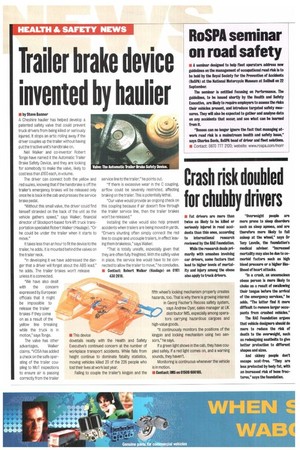Trailer brake device invented by haulier
Page 18

If you've noticed an error in this article please click here to report it so we can fix it.
• by Steve Banner A Cheshire haulier has helped develop a patented safety valve that could prevent truck drivers from being killed or seriously injured. It stops an artic rolling away if the driver couples up the trailer without having put the tractive unit's handbrake on.
Neil Walker and co-inventor Robert Tonge have named it the Automatic Trailer Brake Safety Device, and they are looking for somebody to make the valve, likely to cost less than £100 each, in volume.
The driver can connect both the yellow and red suzies, knowing that if the handbrake is off the trailer's emergency brakes will be released only once he is back in the cab and presses the service brake pedal.
"Without this small valve, the driver could find himself stranded on the back of the unit as the vehicle gathers speed," says Walker, financial director of Stockport-based fork-lift truck transportation specialist Robert Walker (Haulage). "Or he could be under the trailer when it starts to move."
It takes less than an hour to fit the device to the trailer, he adds. It is mounted behind the valves on the trailer neck.
"In developing it we have addressed the danger that a driver will forget about the ABS lead," he adds. The trailer brakes won't release unless it is connected.
"We have also dealt with the concern expressed by European officials that it might be impossible to release the trailer brakes if they come on as a result of the yellow line breaking while the truck is in motion," says Tonge.
The valve has other advantages, Walker claims. "VOSA has added a check on the safe operating of the trailer coupling to MoT inspections to ensure air is passing correctly from the trailer service line to the trailer," he points out.
"If there is excessive wear in the C coupling, airflow could be severely restricted, affecting braking on the trailer. This is potentially lethal.
"Our valve would provide an ongoing check on this coupling because if air doesn't flow through the trailer service line, then the trailer brakes won't be released."
Installing the valve would also help prevent accidents when trailers are being moved in yards. "Drivers shunting often simply connect the red line to couple and uncouple trailers, in effect leaving them brakeless," says Walker.
"That is totally unsafe, especially given that they are often fully freighted. With the safety valve in place, the service line would have to be connected to allow the trailer to move," he concludes.
• Contact: Robert Walker (Haulage) on 0161 430 2618.
































































































































































